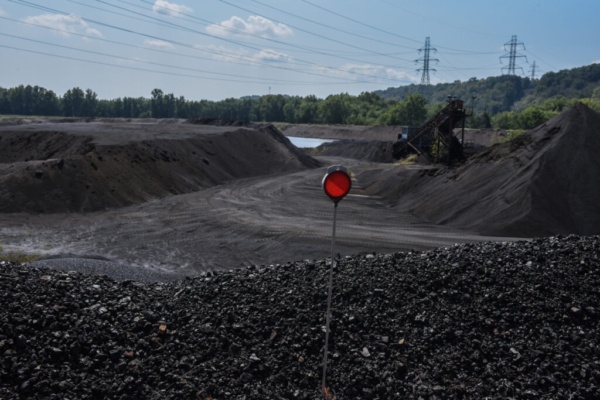By: Robert Zullo
November 7, 2022
Duke Energy facility in NC cited as among the worst contamination sites, but company pushes back
In the wake of major coal ash spills from power plant containment ponds in Tennessee and into the Dan River along the North Carolina and Virginia border, the Environmental Protection Agency in 2015 laid out the first federal rules for managing the ash, one of the nation’s largest waste streams, and the toxins it contains.
But more than seven years later, few utilities and other owners responsible for the often unlined pits where billions of tons of ash leach heavy metals and other toxins into groundwater are planning comprehensive cleanups, per a report released last Thursday by a pair of environmental groups.
“This report serves as a warning bell for the need to change course to ensure that the federal rule actually restores coal ash-contaminated groundwater, closes all unlined and leaking coal ash ponds and prevents future water contamination,” the report by the Environmental Integrity Project and Earthjustice says. “Progress to clean up contaminated groundwater and safely close dangerous coal ash ponds is dismal. Industry data reveal ongoing groundwater contamination and widespread violations of the federal rule.”
The report contains information on groundwater contamination, including levels of arsenic, cobalt, lithium, thallium, selenium, boron, lead and other toxins, at nearly 300 coal plant sites in 43 states and ranks the 10 top most contaminated sites, which it says are in Nevada, North Carolina, Pennsylvania, Maryland, Tennessee, Wyoming, Mississippi and Texas, based on sampling data released by the owners of the sites. Many are in low-income communities and communities of color and almost all of them (91%) are contaminating the groundwater, the report contends.
“Quite simply, most coal plants are violating the law that requires toxic waste cleanup,” said Lisa Evans, a senior attorney with Earthjustice, during a Thursday media call. “Coal plants are polluting the nation’s water illegally and getting away with it.”
Abel Russ, a senior attorney with the Environmental Integrity Project, said the EPA’s 2015 regulations, called the Disposal of Coal Combustion Residuals from Electric Utilities rule, have done a decent job of laying out the scope of the problem at coal ash sites across the country.
“But of course the rule is also meant to do something about the problem and stimulate cleanup and corrective action and we’re not seeing that as much as we should be seeing,” Russ said.
Enforcement lagged during the Trump administration, and both organizations have been pushing the EPA to take more action to prod plant owners to clean up contamination, Russ and Evans said.
“This rule was promulgated in 2015 followed by four years of the Trump administration where the EPA did nothing but try to remove the coal ash rule. They did not try to enforce it, there were no pronouncements on what the rule meant. And so in January of this year … EPA has started to enforce the rule. But it is industry’s argument that they’re doing it in some new or novel way, which is total nonsense.”
An EPA spokeswoman said the agency would review the report but did not answer specific questions about enforcement of the 2015 rule. Bill Norton, a spokesman for Duke Energy, which has coal ash units at 20 different facilities in five states, said the company is “making great progress” on closing coal ash ponds.
“We are pursuing corrective action at each site to address any groundwater contamination, and our work won’t be done until it is fully addressed,” he said. “As that work proceeds, it is critical to note that drinking and recreational water supplies remain safe from ash impacts.”
He said the Environmental Integrity Project’s news release on the report — which lists the company’s Allen Steam Station in Belmont, North Carolina, as one of the 10 worst coal ash contamination sites in the country and claims Duke doesn’t plan to treat groundwater — isn’t accurate.
“We are actively treating the groundwater at Allen and it has already begun to improve. We are also building new lined landfills and are excavating both ash basins and the landfill under approved closure plans that NCDEQ confirmed are “protective of public health and the environment,” Norton said.
He also called the report’s methodology flawed because the high cobalt levels at Allen are “deep within the interior” of the site and groundwater flows away from neighbors.
“Separate private well testing by state regulators in North Carolina did not observe elevated levels of cobalt or any other ash impacts in neighbors’ well water near the Allen plant, and regular surface water sampling shows Lake Wylie continues to remain safe from coal ash impacts,” he said.
Attempts to reach GenOn, which operates two facilities, one in Maryland and one in Pennsylvania, that were listed among the 10 most contaminated in the country, for comment were unsuccessful.
‘Common tricks’
Local activists said coal ash pollution has plagued their communities for years.
“This report chronicles the bad faith of big coal in America that has created public and environmental health problems that will take generations to clean up in some cases,” said Fred Tutman, the Patuxent Riverkeeper, who has fought to force GenOn to clean up pollution from its coal ash landfill in Brandywine, about 24 miles southeast of Washington in Maryland. “All in pursuit of ill-gotten profits while they seek to evade sustainability or accountability. It’s an ugly story and people need to take heed.”
Tim Maloney, senior policy director for the Hoosier Environmental Council, said during a news conference that coal ash has contaminated drinking water wells in four Indiana communities, including the town of Pines, a Superfund site, and has rendered groundwater unusable at 10 other sites across the state.
“Despite knowing for years about the contamination caused by their coal ash, at most of our 17 power plant sites where toxic metals are leaking from ash dumps, the power companies still don’t know the full extent of the contamination or have specific plans to clean up these dumps,” Maloney said.
The report also says utilities and ash dump owners are obfuscating actual levels of pollution and exploiting loopholes to avoid cleanup costs.
“To save money and avoid liability, coal plant owners ignore critical requirements and employ common tricks to avoid mandatory cleanup requirements,” the report says.
For instance, it’s up to coal plant operators to make the initial determination as to which ash pits are subject to the rule, since plants that operated for decades often have multiple ash disposal areas, some that may not have accepted new waste for years.
As an example, Duke Energy long considered two old coal ponds at the Gallagher Generating Station in New Albany, Indiana, that had been drained and covered with soil and grass as exempt from the rule even though the ash was “sitting in approximately 20 feet of groundwater,” the U.S. Environmental Protection Agency wrote to the company in June.
There are 200 unlined coal ash impoundments in 30 states that plan to close without removing any ash, even though the waste is within five feet of groundwater, creating the potential for heavy metals to continue leaching out for years, the report says.
Plant owners are also rigging groundwater data to cover up the degree of groundwater contamination, the report contends. It cites an example of a Florida facility in which a so-called “background” monitoring well — designed to establish baseline levels of water contaminants before it comes into contact with coal ash — was designated as upgradient of the ash ponds even though it was actually downgradient. The effect is to make it seem as if the ash isn’t contributing significant contamination to the groundwater.
“When plant owners illegally install ‘background’ wells that are already contaminated by coal ash, they can avoid cleanup requirements. Cleanups are triggered, according to the rule, when downgradient wells (wells placed to detect water passing the boundary of a landfill or pond) show a statistically significant increase in coal ash contaminants when compared to wells reflecting the original condition of the groundwater,” the report says.
Even when the upgradient wells are properly designated, sometimes coal ash unit owners don’t compare those background wells with the monitoring wells designed to identify contamination.
“Instead of comparing downgradient wells to upgradient wells, they analyze the data for each well in isolation,” the report says. “This does not work at most coal plants because the groundwater is already contaminated.”
More than 100 coal ash dumps regulated by the rule use that technique, called “intrawell analysis.”
And when they embark on cleanup efforts, ash dump operators fail to restore groundwater quality, drag their feet by failing to choose a solution or opt for “monitored natural attenuation” to address contamination, even though that essentially means groundwater monitoring without a clean up plan, the report says.
The groups say state and federal regulators should push coal plant owners to remove ash from pits and place it in sealed landfills away from surface and groundwater, which can be pumped up and treated. The report calls for more monitoring wells, more testing of nearby surface water and private drinking water wells, correct analysis of groundwater data and prompt clean-up action, among other provisions. It also calls on the EPA to step up enforcement and revise the rule itself so that it no longer exempts older coal ash units.
“This is not a problem that can’t be solved,” Evans said. “The problem is the intransigence of the industry in not being willing to solve the problem.“





